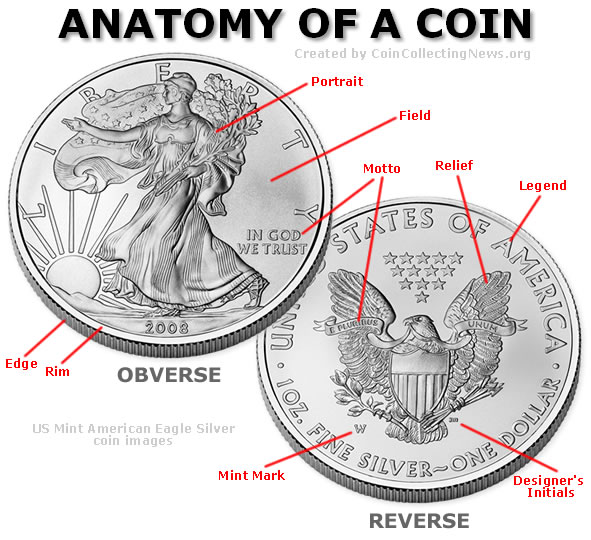Anatomy of Silver Coins
The anatomy of silver coins, or any coin for that matter, is depicted in the following American Eagle Silver coin image. Term descriptions are provided below as well.

Obverse: The top of heads side of a coin. Usually the side with the coin’s date and portrait design.
Reverse: The back or tails side of a coins.
Rim: The raised edge on both sides that runs completely around a coin. The design helps protect a coin’s design from wear, and makes coins easier to stack.
Edge: Often called the "third side" of a coin, the edge is the very outer border of a coin. Edges can be lettered, like the new U.S. Presidential $1 coins, plain, reeded, or decorated.
Legend: The main letters, often referred to the coin’s inscription.
Motto: Coin lettering or inscriptions like "In God We Trust," "E Pluribus Unum," and "Liberty."
Mint Mark: The always small letter or symbol on a coin that indicates where a coin was minted. In the U.S., common mint marks include Philadelphia "P", Denver "D", San Francisco "S", and West Point "W."
Portrait: Generally, the main part of a coin’s design. Common portraits include presidents, kings, queens, and Liberty.
Field: The flat area of a coin’s surface that is not raised and doesn’t have any design or inscription.
Relief: The part of a coin’s design that is raised above the surface.
Date: Indicates the year a coin was minted or first issued.
Designers Initials: The initials of the person who designed the coin.
Coin image courtesy of Coin Collecting News.
![[Most Recent Quotes from www.kitco.com]](http://www.kitconet.com/images/quotes_2a.gif)